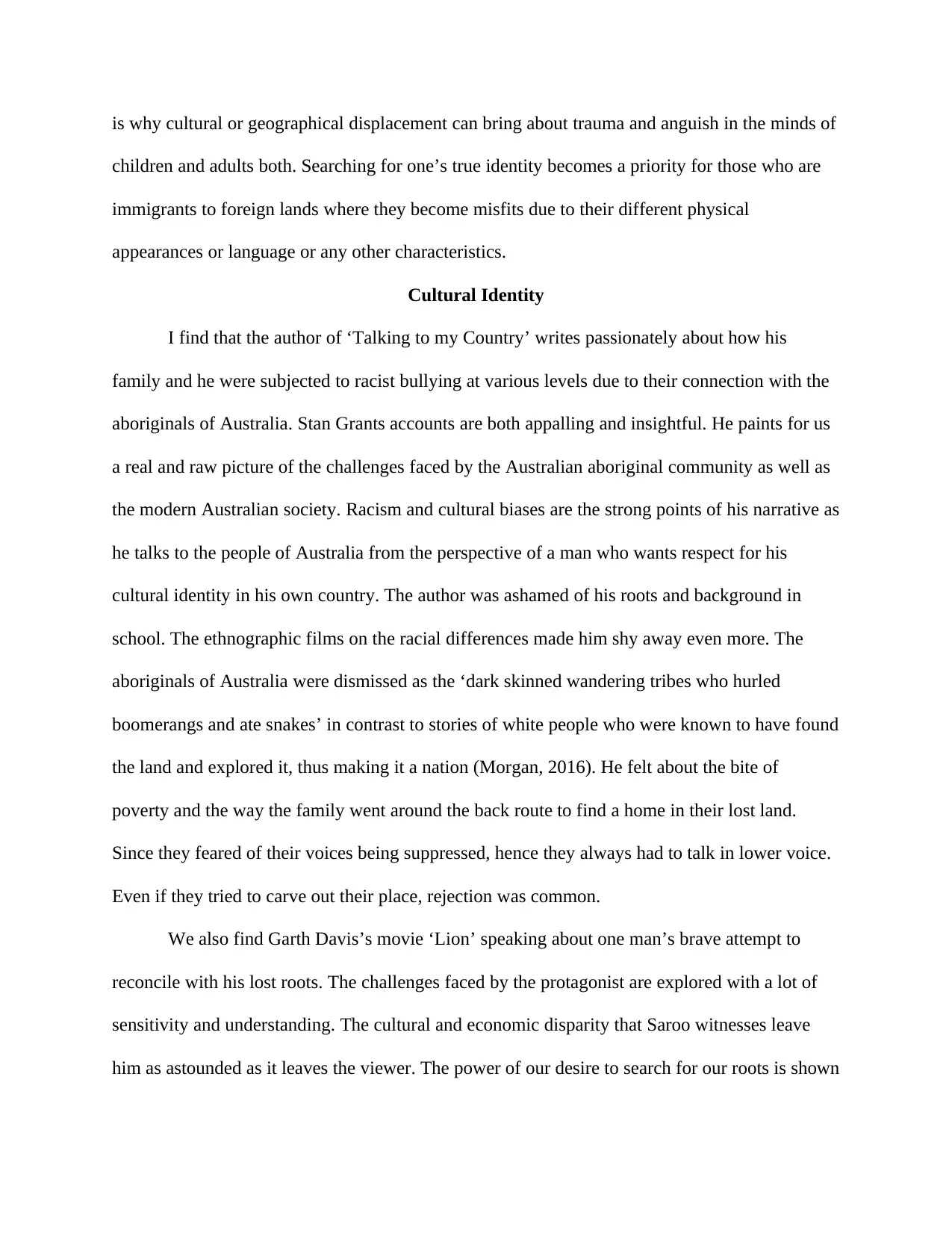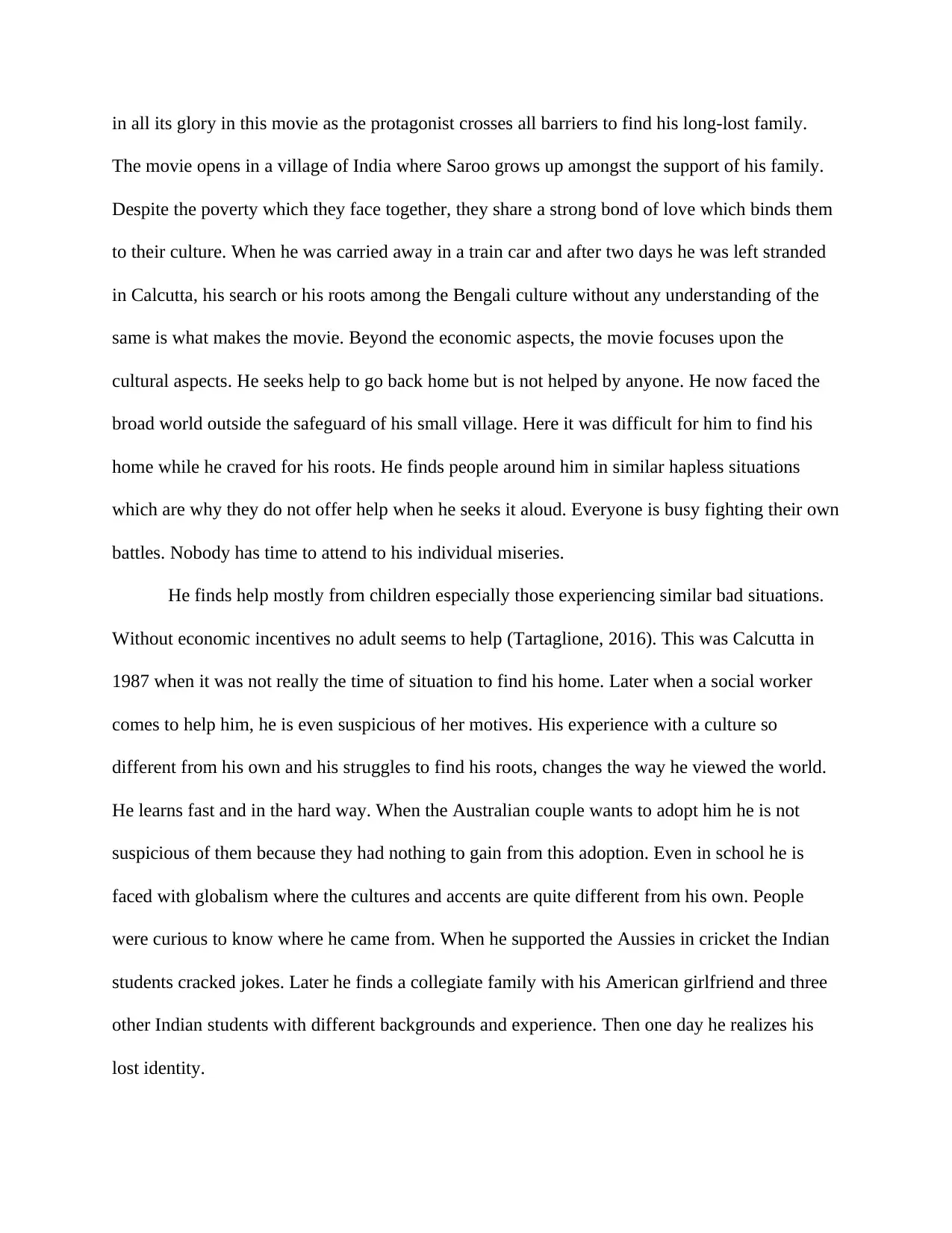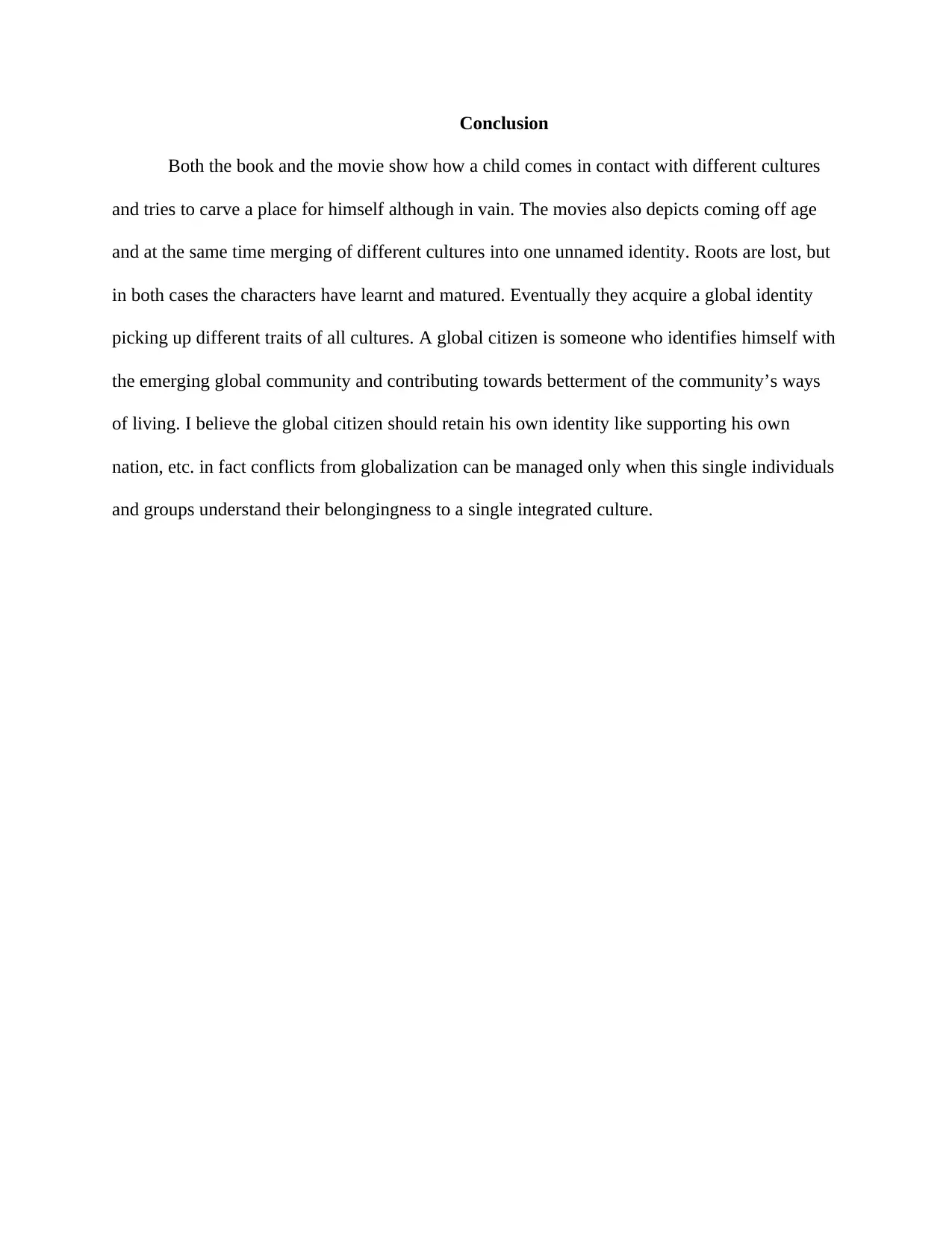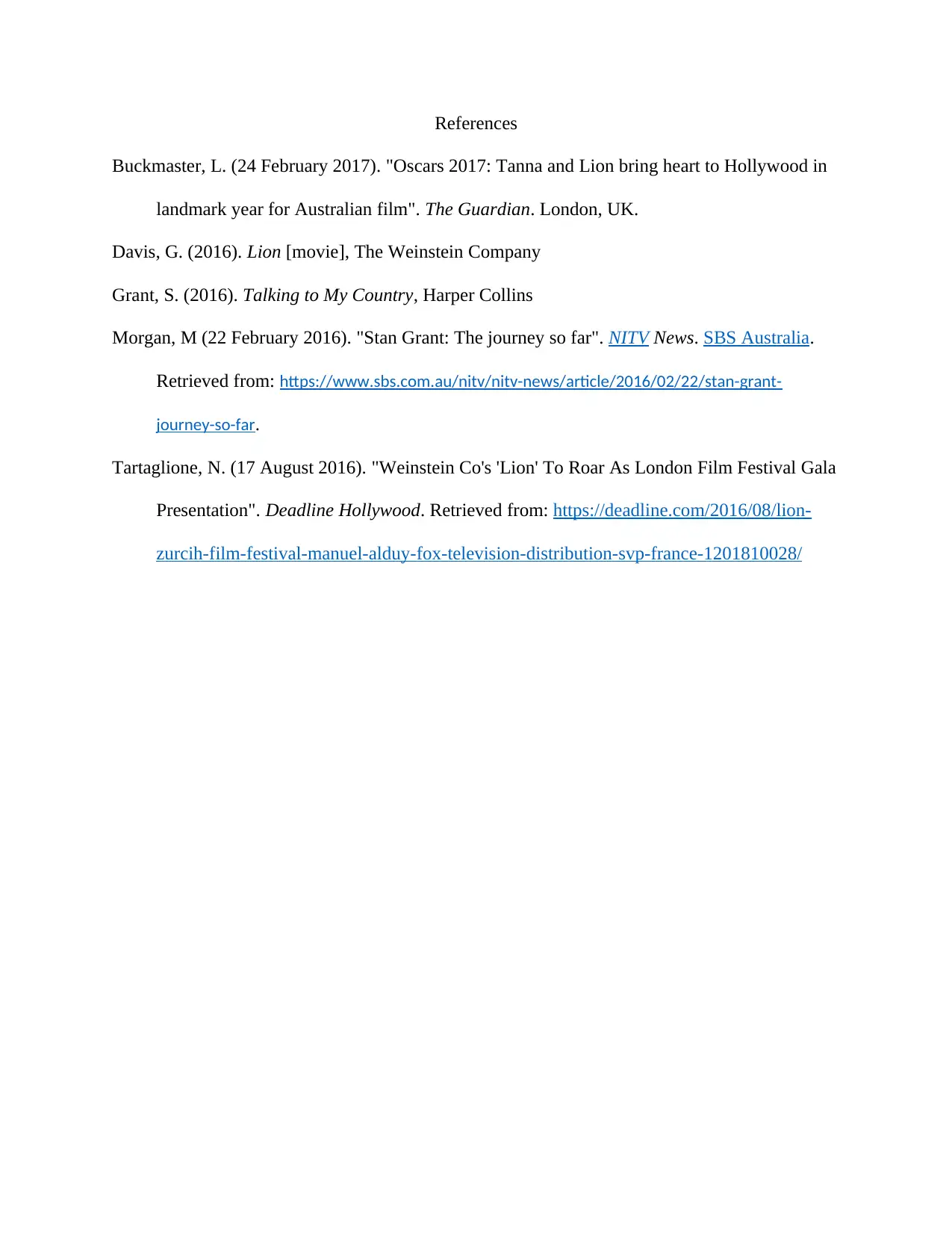Exploring Identity: 'Talking to My Country' and 'Lion' Analysis
VerifiedAdded on 2023/01/13
|5
|1449
|80
Essay
AI Summary
This essay explores the central theme of identity and the search for belonging, as depicted in Stan Grant's book 'Talking to My Country' and Garth Davis's film 'Lion'. The analysis delves into how both works portray the protagonists' quests for their roots, whether cultural or familial, and the emotional upheavals they experience due to displacement. The essay highlights the impact of cultural and geographical displacement, particularly for immigrants, and examines the challenges faced by the protagonists in navigating racism, cultural biases, and economic disparities. Through a comparative approach, the essay underscores the significance of cultural identity and the human desire to connect with one's origins. The essay also examines how both the book and the movie shows characters' journeys to finding a sense of belonging, eventually developing a global identity while retaining aspects of their original cultures, emphasizing the importance of understanding one's belongingness in a global community.

Literary Article
Introduction
Every individual in this world has an inherent need to belong. In both Stan Grant’s
Talking to my Country as well as Garth Davis’s movie ‘Lion’, the main protagonists seek their
real identities in the world. This search for one’s identity is the basis for both of these texts.
Whether it means a ‘cultural’ identity or a connection with one’s family, the desire to find and go
back to one’s roots is intense in all of us. The author of the book ‘Talking to my country’ is an
Australian aboriginal and identifies with his people back in his country. This bond that we share
with people from our own culture or race is essentially the search for our ‘roots’ or our basic
identity as a person or an individual. Even Garth Davis explores the subject of searching for
one’s roots through his cinematic medium named ‘Lion’ (Buckmaster, 2017). In the movie, the
film-maker constructs the varied perspectives of an Indian boy and his Australian adopted family
and how they cope with his quest for his actual family back in India. This quest is symbolic of
the journey that the protagonist Saroo has to undergo in order to find his real self, who he was
before his life changed.
The questions asked by the authors or the film makers of books and movies depicting this
theme are essentially the same. ‘Who am I?’, ‘Why do I feel that I do not belong here?’, ‘Where
have I come from?’ ‘Why am I different?’, all these questions come from similar feelings of
displacement and emotional upheavals that such individuals have to go through in life. In a
sense, we all want to feel safe and secured by a family and a similar cultural or geographical
environment. Human beings have an instinctive desire to form social groups with those around
them and create a sense of belonging amongst similar looking people with a common language,
location, physical appearances etc. This is the basis of our organized societies and cultures. That
Introduction
Every individual in this world has an inherent need to belong. In both Stan Grant’s
Talking to my Country as well as Garth Davis’s movie ‘Lion’, the main protagonists seek their
real identities in the world. This search for one’s identity is the basis for both of these texts.
Whether it means a ‘cultural’ identity or a connection with one’s family, the desire to find and go
back to one’s roots is intense in all of us. The author of the book ‘Talking to my country’ is an
Australian aboriginal and identifies with his people back in his country. This bond that we share
with people from our own culture or race is essentially the search for our ‘roots’ or our basic
identity as a person or an individual. Even Garth Davis explores the subject of searching for
one’s roots through his cinematic medium named ‘Lion’ (Buckmaster, 2017). In the movie, the
film-maker constructs the varied perspectives of an Indian boy and his Australian adopted family
and how they cope with his quest for his actual family back in India. This quest is symbolic of
the journey that the protagonist Saroo has to undergo in order to find his real self, who he was
before his life changed.
The questions asked by the authors or the film makers of books and movies depicting this
theme are essentially the same. ‘Who am I?’, ‘Why do I feel that I do not belong here?’, ‘Where
have I come from?’ ‘Why am I different?’, all these questions come from similar feelings of
displacement and emotional upheavals that such individuals have to go through in life. In a
sense, we all want to feel safe and secured by a family and a similar cultural or geographical
environment. Human beings have an instinctive desire to form social groups with those around
them and create a sense of belonging amongst similar looking people with a common language,
location, physical appearances etc. This is the basis of our organized societies and cultures. That
Paraphrase This Document
Need a fresh take? Get an instant paraphrase of this document with our AI Paraphraser

is why cultural or geographical displacement can bring about trauma and anguish in the minds of
children and adults both. Searching for one’s true identity becomes a priority for those who are
immigrants to foreign lands where they become misfits due to their different physical
appearances or language or any other characteristics.
Cultural Identity
I find that the author of ‘Talking to my Country’ writes passionately about how his
family and he were subjected to racist bullying at various levels due to their connection with the
aboriginals of Australia. Stan Grants accounts are both appalling and insightful. He paints for us
a real and raw picture of the challenges faced by the Australian aboriginal community as well as
the modern Australian society. Racism and cultural biases are the strong points of his narrative as
he talks to the people of Australia from the perspective of a man who wants respect for his
cultural identity in his own country. The author was ashamed of his roots and background in
school. The ethnographic films on the racial differences made him shy away even more. The
aboriginals of Australia were dismissed as the ‘dark skinned wandering tribes who hurled
boomerangs and ate snakes’ in contrast to stories of white people who were known to have found
the land and explored it, thus making it a nation (Morgan, 2016). He felt about the bite of
poverty and the way the family went around the back route to find a home in their lost land.
Since they feared of their voices being suppressed, hence they always had to talk in lower voice.
Even if they tried to carve out their place, rejection was common.
We also find Garth Davis’s movie ‘Lion’ speaking about one man’s brave attempt to
reconcile with his lost roots. The challenges faced by the protagonist are explored with a lot of
sensitivity and understanding. The cultural and economic disparity that Saroo witnesses leave
him as astounded as it leaves the viewer. The power of our desire to search for our roots is shown
children and adults both. Searching for one’s true identity becomes a priority for those who are
immigrants to foreign lands where they become misfits due to their different physical
appearances or language or any other characteristics.
Cultural Identity
I find that the author of ‘Talking to my Country’ writes passionately about how his
family and he were subjected to racist bullying at various levels due to their connection with the
aboriginals of Australia. Stan Grants accounts are both appalling and insightful. He paints for us
a real and raw picture of the challenges faced by the Australian aboriginal community as well as
the modern Australian society. Racism and cultural biases are the strong points of his narrative as
he talks to the people of Australia from the perspective of a man who wants respect for his
cultural identity in his own country. The author was ashamed of his roots and background in
school. The ethnographic films on the racial differences made him shy away even more. The
aboriginals of Australia were dismissed as the ‘dark skinned wandering tribes who hurled
boomerangs and ate snakes’ in contrast to stories of white people who were known to have found
the land and explored it, thus making it a nation (Morgan, 2016). He felt about the bite of
poverty and the way the family went around the back route to find a home in their lost land.
Since they feared of their voices being suppressed, hence they always had to talk in lower voice.
Even if they tried to carve out their place, rejection was common.
We also find Garth Davis’s movie ‘Lion’ speaking about one man’s brave attempt to
reconcile with his lost roots. The challenges faced by the protagonist are explored with a lot of
sensitivity and understanding. The cultural and economic disparity that Saroo witnesses leave
him as astounded as it leaves the viewer. The power of our desire to search for our roots is shown

in all its glory in this movie as the protagonist crosses all barriers to find his long-lost family.
The movie opens in a village of India where Saroo grows up amongst the support of his family.
Despite the poverty which they face together, they share a strong bond of love which binds them
to their culture. When he was carried away in a train car and after two days he was left stranded
in Calcutta, his search or his roots among the Bengali culture without any understanding of the
same is what makes the movie. Beyond the economic aspects, the movie focuses upon the
cultural aspects. He seeks help to go back home but is not helped by anyone. He now faced the
broad world outside the safeguard of his small village. Here it was difficult for him to find his
home while he craved for his roots. He finds people around him in similar hapless situations
which are why they do not offer help when he seeks it aloud. Everyone is busy fighting their own
battles. Nobody has time to attend to his individual miseries.
He finds help mostly from children especially those experiencing similar bad situations.
Without economic incentives no adult seems to help (Tartaglione, 2016). This was Calcutta in
1987 when it was not really the time of situation to find his home. Later when a social worker
comes to help him, he is even suspicious of her motives. His experience with a culture so
different from his own and his struggles to find his roots, changes the way he viewed the world.
He learns fast and in the hard way. When the Australian couple wants to adopt him he is not
suspicious of them because they had nothing to gain from this adoption. Even in school he is
faced with globalism where the cultures and accents are quite different from his own. People
were curious to know where he came from. When he supported the Aussies in cricket the Indian
students cracked jokes. Later he finds a collegiate family with his American girlfriend and three
other Indian students with different backgrounds and experience. Then one day he realizes his
lost identity.
The movie opens in a village of India where Saroo grows up amongst the support of his family.
Despite the poverty which they face together, they share a strong bond of love which binds them
to their culture. When he was carried away in a train car and after two days he was left stranded
in Calcutta, his search or his roots among the Bengali culture without any understanding of the
same is what makes the movie. Beyond the economic aspects, the movie focuses upon the
cultural aspects. He seeks help to go back home but is not helped by anyone. He now faced the
broad world outside the safeguard of his small village. Here it was difficult for him to find his
home while he craved for his roots. He finds people around him in similar hapless situations
which are why they do not offer help when he seeks it aloud. Everyone is busy fighting their own
battles. Nobody has time to attend to his individual miseries.
He finds help mostly from children especially those experiencing similar bad situations.
Without economic incentives no adult seems to help (Tartaglione, 2016). This was Calcutta in
1987 when it was not really the time of situation to find his home. Later when a social worker
comes to help him, he is even suspicious of her motives. His experience with a culture so
different from his own and his struggles to find his roots, changes the way he viewed the world.
He learns fast and in the hard way. When the Australian couple wants to adopt him he is not
suspicious of them because they had nothing to gain from this adoption. Even in school he is
faced with globalism where the cultures and accents are quite different from his own. People
were curious to know where he came from. When he supported the Aussies in cricket the Indian
students cracked jokes. Later he finds a collegiate family with his American girlfriend and three
other Indian students with different backgrounds and experience. Then one day he realizes his
lost identity.
⊘ This is a preview!⊘
Do you want full access?
Subscribe today to unlock all pages.

Trusted by 1+ million students worldwide

Conclusion
Both the book and the movie show how a child comes in contact with different cultures
and tries to carve a place for himself although in vain. The movies also depicts coming off age
and at the same time merging of different cultures into one unnamed identity. Roots are lost, but
in both cases the characters have learnt and matured. Eventually they acquire a global identity
picking up different traits of all cultures. A global citizen is someone who identifies himself with
the emerging global community and contributing towards betterment of the community’s ways
of living. I believe the global citizen should retain his own identity like supporting his own
nation, etc. in fact conflicts from globalization can be managed only when this single individuals
and groups understand their belongingness to a single integrated culture.
Both the book and the movie show how a child comes in contact with different cultures
and tries to carve a place for himself although in vain. The movies also depicts coming off age
and at the same time merging of different cultures into one unnamed identity. Roots are lost, but
in both cases the characters have learnt and matured. Eventually they acquire a global identity
picking up different traits of all cultures. A global citizen is someone who identifies himself with
the emerging global community and contributing towards betterment of the community’s ways
of living. I believe the global citizen should retain his own identity like supporting his own
nation, etc. in fact conflicts from globalization can be managed only when this single individuals
and groups understand their belongingness to a single integrated culture.
Paraphrase This Document
Need a fresh take? Get an instant paraphrase of this document with our AI Paraphraser

References
Buckmaster, L. (24 February 2017). "Oscars 2017: Tanna and Lion bring heart to Hollywood in
landmark year for Australian film". The Guardian. London, UK.
Davis, G. (2016). Lion [movie], The Weinstein Company
Grant, S. (2016). Talking to My Country, Harper Collins
Morgan, M (22 February 2016). "Stan Grant: The journey so far". NITV News. SBS Australia.
Retrieved from: https://www.sbs.com.au/nitv/nitv-news/article/2016/02/22/stan-grant-
journey-so-far.
Tartaglione, N. (17 August 2016). "Weinstein Co's 'Lion' To Roar As London Film Festival Gala
Presentation". Deadline Hollywood. Retrieved from: https://deadline.com/2016/08/lion-
zurcih-film-festival-manuel-alduy-fox-television-distribution-svp-france-1201810028/
Buckmaster, L. (24 February 2017). "Oscars 2017: Tanna and Lion bring heart to Hollywood in
landmark year for Australian film". The Guardian. London, UK.
Davis, G. (2016). Lion [movie], The Weinstein Company
Grant, S. (2016). Talking to My Country, Harper Collins
Morgan, M (22 February 2016). "Stan Grant: The journey so far". NITV News. SBS Australia.
Retrieved from: https://www.sbs.com.au/nitv/nitv-news/article/2016/02/22/stan-grant-
journey-so-far.
Tartaglione, N. (17 August 2016). "Weinstein Co's 'Lion' To Roar As London Film Festival Gala
Presentation". Deadline Hollywood. Retrieved from: https://deadline.com/2016/08/lion-
zurcih-film-festival-manuel-alduy-fox-television-distribution-svp-france-1201810028/
1 out of 5
Related Documents
Your All-in-One AI-Powered Toolkit for Academic Success.
+13062052269
info@desklib.com
Available 24*7 on WhatsApp / Email
![[object Object]](/_next/static/media/star-bottom.7253800d.svg)
Unlock your academic potential
Copyright © 2020–2025 A2Z Services. All Rights Reserved. Developed and managed by ZUCOL.



